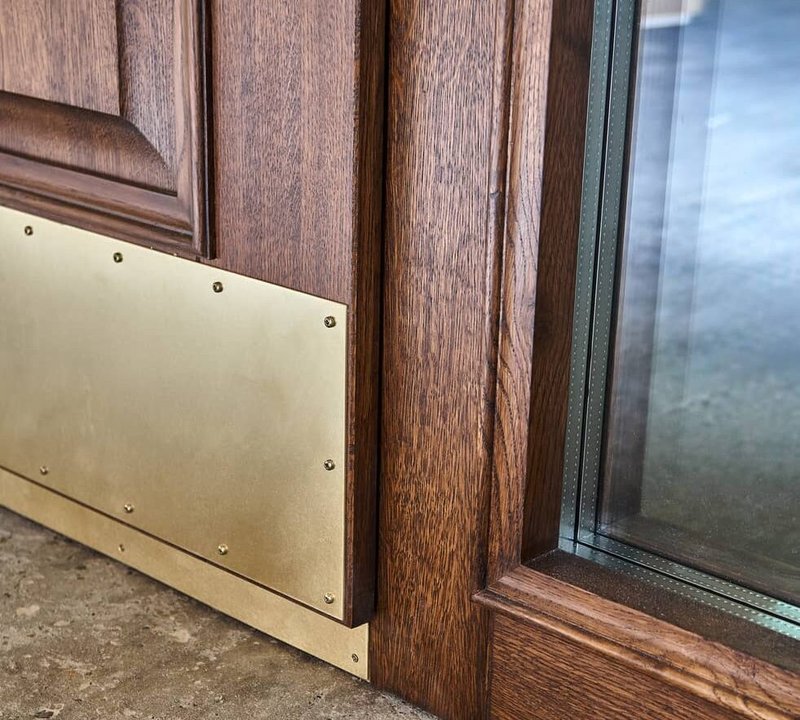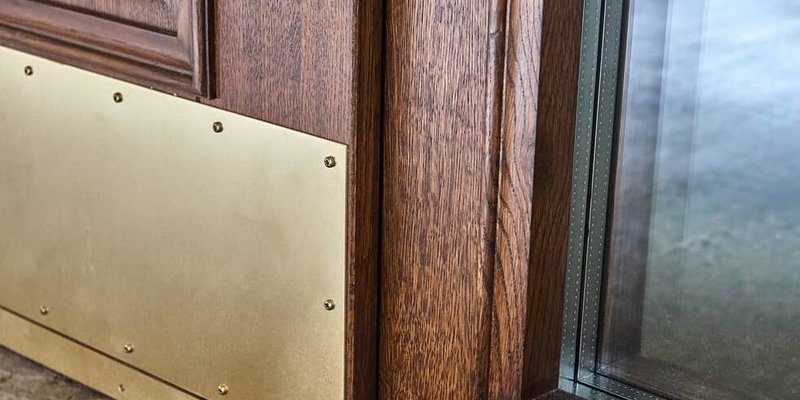
Kick plates aren’t just about looks, either. They’re functional. These metal plates take the brunt of scuffs, shoes, and even the occasional pet claw. But when a kick plate is too long or too short, it can snag, shift, or leave parts of your door unprotected. If your kick plate isn’t fitting the way it should, don’t worry—fixing this is totally doable, even if you’re not a DIY pro. Let’s walk through what’s going on, why it’s happening, and step-by-step ways you can solve it, using clear tools and a little troubleshooting know-how.
Why Kick Plate Sizing Is So Important
Kick plates aren’t just decorative strips of metal—they have an important job. They protect the bottom portion of your door from damage and wear, especially in busy households or businesses where doors see a lot of action. If your kick plate is too long, it might poke past the edges of the door, making it easy to catch on shoes, clothing, or even scratch your floors. If it’s too short, parts of your door stay exposed and vulnerable to scuffs and dents.
Here’s the thing: most kick plates are designed with a little leeway for trimming, but not every door has standard measurements. If you bought a standard-sized plate for a door that’s a bit smaller or wider than average, you’re likely to run into this problem. Plus, brands like Stanley or Schlage may have slightly different sizing conventions, so what fits perfectly on one door could look off on another. Sizing isn’t just about numbers on a tape measure—it’s about making everything look and feel right.
You might be tempted to just “make it work,” but honestly, a poorly fitted kick plate can be more of an eyesore (and tripping hazard) than not having one at all. That’s why getting this detail right is worth your time.
Common Reasons Kick Plates Don’t Fit
Before you jump into cutting, ordering, or returning, let’s look at why your kick plate might not be the perfect fit. Sometimes the issue has nothing to do with your measuring skills—it’s all about how doors and kick plates are made.
- Standardization Issues: Not all doors are created equal. An “average” door is usually 36 inches wide, but plenty are narrower or wider. Kick plates usually come in sizes like 30, 32, or 36 inches, but rarely match custom or vintage doors.
- Brand Variations: Brands like Schlage vs. Stanley might have slightly different ways of rounding edges, drilling holes, or marking dimensions. This inconsistency can leave you with a plate that’s a hair too long or frustratingly short.
- Door Hardware Conflicts: If you have decorative trim, raised panels, or bottom sweeps, the standard kick plate might interfere with hardware or look misaligned. The plate might even bump into a code-required weather sweep.
- Mix-Ups During Ordering: Maybe you measured the door, not the part you wanted covered. Or maybe you mixed up metric and imperial units (it happens!).
Using a little troubleshooting, you can usually figure out the root cause quickly. Remind yourself: a wrong-sized kick plate isn’t a total disaster, it’s just a detail to tweak.
How to Measure Your Door for the Right Kick Plate Size
Honestly, careful measuring is half the battle. But what does “careful measuring” even mean when doors have odd trims or weatherstrips? Let me explain.
Here’s a trustworthy way to measure for a perfect kick plate fit:
- Width: Measure the distance between the two outer edges of the flat part at the bottom of your door. Ignore any decorative trim or the door jamb itself—just focus on the “clean” part of the door’s face.
- Height: Kick plates are typically 6 to 10 inches tall. Most people go for 8 inches, but check if your door bottom has unique features (like a thick sweep or recessed panel).
- Hardware Distance: Make sure your kick plate can sit flat without covering up or interfering with locks, sweeps, or weatherstripping.
- Double-Check: I can’t stress this enough—measure twice, order once. Mismatched sizes usually come from small slip-ups here.
If you’re replacing an old kick plate, pull it off and use it as a template. For new installs, a cardboard cutout at your measured size helps you “test” the fit before you commit to drilling or gluing on your brand-new plate.
Fixing a Kick Plate That’s Too Long
So you ended up with a kick plate that pokes past the edge of your door—a few inches too long. No need to panic (or toss it). There are a couple of smart ways to fix this.
- Trim It Down: If you have a metal kick plate, use a fine-tooth hacksaw or metal-cutting snips to trim it to size. Mark where you want to cut using painter’s tape and a ruler for a straight line. Go slow and steady—you want a clean edge, not a jagged one.
- Smooth the Edges: After trimming, sand down the cut edge with a metal file. This step matters for both safety (no sharp bits) and looks.
- Drill New Holes if Needed: The holes for screws might have been cut off or moved. Use a power drill to make new ones, using the old positions as a guide.
- Paint or Polish (Optional): If you scratched the finish while cutting, touch up with matching spray paint or metal polish for a seamless look.
If you’re not comfortable with metalwork, most hardware stores or local locksmiths can trim and finish a kick plate for you (usually for a small fee).
Fixing a Kick Plate That’s Too Short
Now what if your kick plate is a little too short? Maybe you bought a 30-inch plate for a 32-inch door, or the style just leaves too much open space. Here’s how to handle that:
- Center the Plate: If the plate is only a tiny bit short, centering it can make the gap less obvious. As long as both sides have equal exposed areas, it often looks intentional and tidy.
- Add Decorative End Caps: Some brands make metal or rubber end caps that fill the space, cover the gap, and match the plate’s finish.
- Order a Custom Plate: When the gap is bigger than an inch or two, it’s worth reaching out to the brand or a local metal shop. Most companies will cut to size if you give them exact measurements. This is the best way to guarantee a perfect fit.
- Consider a Universal Kick Plate: Universal kick plates are usually oversized and meant to be trimmed down, so they work with a larger range of doors, but you still need to cut them to your measurements.
Here’s an insight:
“A too-short kick plate can sometimes look intentional, but a too-long one almost never does. If you’re on the fence, err on the side of trimming down instead of living with a big gap.”
Kick Plate Installation Tips for the Best Results
Once you have the right size—either by trimming down or reordering—getting the installation right is what makes the whole project shine. Here’s what makes the difference:
- Clean the Surface: Wipe the door bottom with rubbing alcohol or gentle cleaner. Dirt or dust under the plate leads to poor adhesion and can make the metal wobble or shift.
- Dry Fit First: Hold the plate in place and make sure it covers the surface evenly. Adjust until you’re happy, then mark the screw locations with a pencil.
- Use Correct Fasteners: Some plates come with screws, others have adhesive strips. If you’re re-drilling holes, always use pan-head screws (never countersink!) to prevent damaging the plate.
- Protect the Finish: Place painter’s tape along the edges before drilling or installing to avoid scratching the door or the plate.
If you’re syncing a new kick plate with existing hardware (like a Schlage smart lock or a door code keypad), make sure the plate doesn’t block the code pad or battery compartment. It might sound nitpicky, but those little details prevent headaches later.
Alternatives If Sizing Just Won’t Work
Sometimes, despite your best troubleshooting, a standard kick plate just isn’t going to work—maybe your door is vintage, irregular, or has special trim that prevents a normal fit. What then?
- Custom Fabrication: Many locksmiths and hardware stores offer custom metalwork. Bring your measurements (or old plate) and they can create something that fits perfectly, even for odd-shaped doors.
- Vinyl or Adhesive Guards: For rental properties or temporary fixes, vinyl or stick-on kick plates guard against scuffs and can be trimmed with scissors. They aren’t as tough, but they’re not permanent either.
- Painted Protection: A durable enamel paint or polyurethane clear coat on the door base offers some protection if a plate simply won’t fit. Not as strong as metal, but better than nothing.
Troubleshooting sizing issues reminds you: every door is a little different. Off-the-shelf solutions can be great, but sometimes going custom or using a creative alternative is the only way to protect your door and make it look sharp.
Maintenance and Troubleshooting Common Kick Plate Issues
Even after you get your kick plate to fit just right, it’s worth keeping an eye on it. Kick plates take a lot of abuse, especially on busy doors that sync with code locks, see heavy grocery bags, or the occasional muddy paw.
- Check Fasteners: Every month or two, check that screws or adhesive are holding strong. If the plate shifts, tighten any loose screws or add more adhesive.
- Clean Regularly: Wipe down the plate when you clean your floors. This stops grit from scratching the finish and keeps everything looking new.
- Touch Up Scratches: Small scratches or dings? Use a metal polish or matching paint. This helps prevent rust on steel plates, especially near battery-operated remote locks where moisture can build up.
If the plate starts rattling, warping, or pulling away, it usually means something shifted in the installation or got knocked by accident. In that case, remove the plate, reset or repair the attachment points, and re-install. These small fixes keep your kick plate looking sharp and doing its job as intended.
Bringing It All Together: Getting the Right Kick Plate Fit
Sizing a kick plate is one of those “measure twice, cut once” projects. Doors and plates don’t always sync up perfectly, especially with so many brands, custom options, and old house quirks in the mix. But with careful measuring, a little troubleshooting, and a willingness to trim or go custom, you can get a fit that’s both protective and good-looking.
At the end of the day, a well-fitted kick plate keeps your door looking sharp, protects from daily wear, and adds that satisfying, finished touch. Whether you’re fixing one that’s too long, too short, or starting from scratch, a bit of patience and hands-on work will make a world of difference for your home’s entryway.
